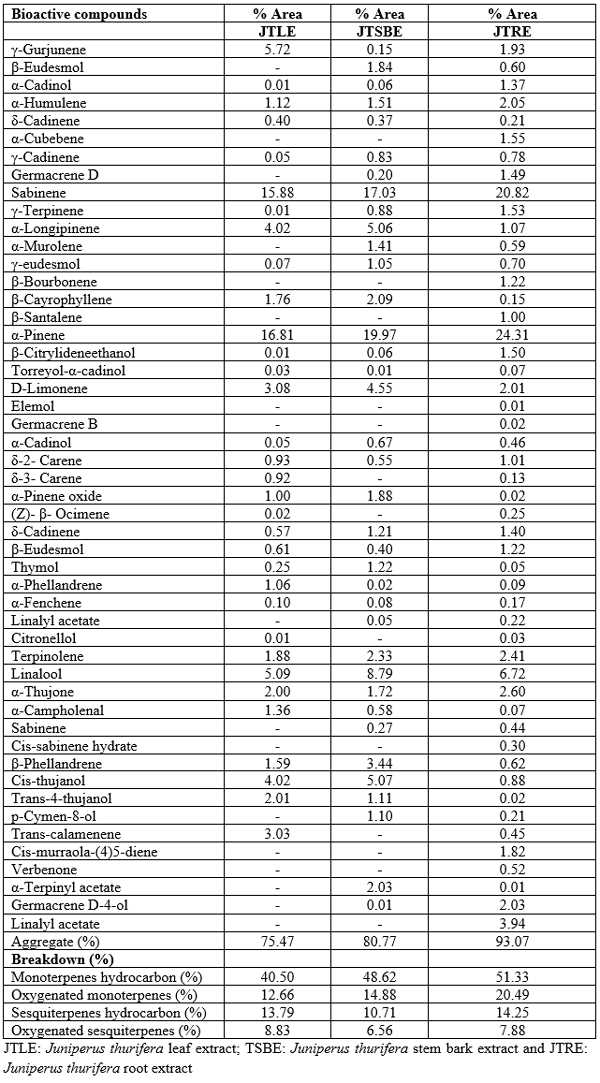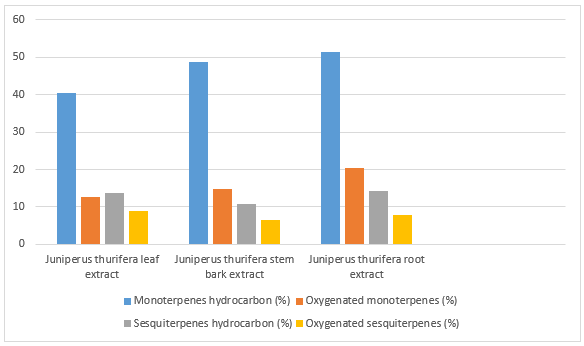Comparative analysis of ethanolic Juniperus thurifera leaf, stem bark and root extract using gas chromatography and mass spectrometry
Medicinal plants are reservoir of bioactive compounds or phytochemicals (terpenoids, alkaloids, tannins, flavonoids and so on) with marked pharmacological properties such as; antimicrobial, antioxidant, anti-inflammatory, antibacterial, analgesics, antiprotozoal, cytotoxic, anti-androgenic, antiviral, antipyretic, antitumor, anti-depressant, hypolipidemic and antihelminthic activities. This study was designed to examine the comparative analysis of ethanolic Juniperus thurifera leaf, stem bark and root extract using gas chromatography and mass spectrometry. Result obtained shows that Juniperus thurifera leaf extract contained 33 bioactive compounds which accounts to 75.47 % while Juniperus thurifera stem bark and root extract contained 37 and 50 phytochemicals with an aggregate of 80.77 % and 93.07 % respectively. Monoterpenes hydrocarbon (40.50 %), oxygenated monoterpenes (12.66 %), sesquiterpenes hydrocarbon (13.79 %) and oxygenated sesquiterpenes were found in Juniperus thurifera leaf extract while Juniperus thurifera stem bark and root extract contains monoterpenes hydrocarbon (48.72 %, 51.33 %), oxygenated monoterpenes (14.88 %, 20.49 %), sesquiterpenes hydrocarbon (10.71 %, 14.25 %) and oxygenated sesquiterpenes (6.56 %, 7.88 %) respectively. It was concluded that Juniperus thurifera leaf, stem bark and root ethanolic extract contains several secondary metabolites which can be used for the treatment of diseases without causing any deleterious effect on the environment and general performance of animals.
Keywords: Gas chromatography, mass spectrometry, Juniperus thurifera, leaf, root, stem bark, phytochemicals.


Muritala, Daniel Shittu., Alagbe, J.O., Ojebiyi, O.O., Ojediran, T.K and Rafiu, T.A. (2022). Growth performance and haematological and serum biochemical parameters of broiler chickens given varied concentrations of Polyalthia longifolia leaf extract in place of conventional antibiotics. Animal Science and Genetics 18(2): 57-71.
Kumar S and Pandey, A.K. (2013) Chemistry and biological activities of flavonoids: an overview. Scientific World Journal 2013: 162750.
Aoki, T., Akashi, T and Ayabe, S. (2000) Flavonoids of leguminous plants: structure, biological activity, and biosynthesis. Journal of Plant Research, 113: 475–488.
Takahashi, A and Ohnishi, T. (2004). The significance of the study about the biological effects of solar ultraviolet radiation using the exposed facility on the international space station. Biological Science Space 18: 255–260.
Kim, S.H and Choi, K.C. (2013) Anti-cancer effect and underlying mechanism(s) of kaempferol, a phytoestrogen, on the regulation of apoptosis in diverse cancer cell models. Toxicological Research, 29: 229–234.
Zheng, W and Wang S.Y. (2001) Antioxidant activity and phenolic compounds in selected herbs. Journal of Agriculture Food Chemistry, 49: 5165–5170.
Khan, M.T., Orhan, I and Enol, S.S. (2009) Cholinesterase inhibitory activities of some flavonoid derivatives and chosen xanthone and their molecular docking studies. Chemical Biological Interaction, 181, 383–389.
Hvattum, E (2002) Determination of phenolic compounds in rose hip (Rosa canina) using liquid chromatography coupled to electrospray ionisation tandem mass spectrometry and diode-array detection. Rapid Communication and Mass Spectrometer, 16: 655–660.
Giusti, M and Wrolstad, R. (2003) Acylated anthocyanins from edible sources and their applications in food systems. Biochemical Engineering Journal, 14: 217–225.
Alagbe John Olujimi, Ramalan Sadiq Muhammad., Shittu Muritala Daniel and Olagoke Olayemi Christiana (2022). Effect of Trichilia monadelpha stem bark extract on the fatty acid composition of rabbit’s thigh meat. Journal of Environmental Issues and Climate Change 1(1): 63-71.
Alagbe, J.O., Shittu, M.D and Tanimomo, Babatunde K. (2022). Influence of Anogeissusleio carpus stem bark on the fatty acid composition in meat of broiler chickens. European Journal of Life Safety and Stability 14(22): 13-22.
Alagbe, J.O (2022). Use of medicinal plants as a panacea to poultry production and food security: A review. Gospodarka I Innowacje 22(2022): 1-12.
Agubosi, O.C.P., Alexander, James and Alagbe, J.O. (2022). Influence of dietary inclusion of Sunflower (Helianthus annus) oil on growth performance and oxidative status of broiler chicks. Central Asian Journal of Medical and Natural Sciences 2(7): 187-195.
Agubosi, O.C.P., Soliu, M.B and Alagbe, J.O. (2022). Effect of dietary inclusion levels of Moringa oleifera oil on the growth performance and nutrient retention of broiler starter chicks. Central Asian Journal of Theoretical and Applied Sciences 3(3): 30-39.
Ruchika, G., Jelena, Z and Sekar, V. (2022). Medicinal plants and natural products in health promotion and disease prevention. Evidence based Complementary and Alternative Medicine, 22:283-291
Alagbe, J.O. (2022). Gas chromatography and mass spectroscopy of Juniperus phoenice stem bark extract and its influence on the haemato-biochemical values of growing rabbits. British Scientific Periodical 1(1): 18-33.
Alagbe, J.O., Zubairu Habiba., Adedeji, O.M., Bamigboye, S and Dora Agbonika (2022). Influence of Juniperus thurifera root extract on the nutrient digestibility and caecal microbial count of growing rabbits. Web of Synergy: International Interdisciplinary Research Journal 1(1): 5-17.
Alagbe, J.O., Shittu, M.D., Ramalan, S.N., Tanimomo, K.B and Adekunle, D.A. (2022). Growth performance, semen quality characteristics and hormonal profile of male rabbit bucks fed Rubia cordifolia root extracts. International Journal of Biological Engineering and Agriculture 1(1): 1-13.
Agubosi, O.C.P., Imudia, Favour Dumkenechukwu and Alagbe, J.O. (2022). Evaluation of the nutritional value of air dried and sun-dried sweet potato (Ipomoea batatas) peels. European Journal of Life Safety and Stability 14(22): 43-51.
Alagbe, J.O., Agubosi, O.C.P., Oluwafemi, R.A and Gabriel Zakara (2022). Efficacy of Trichilia monadelpha stem bark on the growth performance of growing rabbits. British Journal of Innovation in Science, Research and Development, 1(2): 10-19.
Alagbe, J.O. (2022). Prosopis africana (African mesquite) oil as an alternative to antibiotic feed additives on broiler chickens diets: haematology and serum biochemical indices. Central Asian Journal of Theoretical and Applied Sciences 3(2): 19-29.
Agubosi, O.C.P., Wika, B.K and Alagbe, J.O. (2022). Effect of dietary inclusion of Sunflower (Helianthus annus) oil on the growth performance of broiler finisher chickens. European Journal of Modern Medicine and Practice, 2(5): 1-10.
Alagbe, J.O. (2022). Prosopis africana (African mesquite) oil as an alternative to antibiotic feed additives on broiler chickens diets: performance and nutrient retention. Discovery 58(314): 134 -142.
Alagbe, J.O and Ushie, F.T. (2022). Growth performance of broiler chicks fed diets containing different levels of aqueous Citrus aurantium stem bark extracts. Discovery 58(319): 735-741.
Oluwafemi, R.A., Agubosi, O.C.P and Alagbe, J.O. (2021). Proximate, minerals, vitamins and amino acid composition of Prosopis africana (African mesquite) seed oil. Asian Journal of Advances in Research 11(1): 21-27.
Agubosi, O.C.P., Oluwafemi, R.A., and Alagbe, J.O. (2021). Preliminary study on GC-MS analysis of Prosopis africana seed (African mesquite) oil. Journal of Ethics and Diversity in International Communication 1(4): 18-20.
Alagbe, J.O., Adedeji, M.O., Habiba, Z., Nwosu, Gloria and Wyedia Dabara Comfort (2021). Physico-chemical properties of Indigofera zollingineriana seed oil. Asian Journal of Advances in Medical Science 3(4): 306-308.
Alagbe, J.O., Shittu, M.D and Ushie, F.T. (2021). GC-MS analysis of methanolic stem bark extract of Zollingeriana indigofera. Asian Journal of Advances in Research 11(4): 144-146.
Alagbe, J.O (2021). Dietary Supplementation of Rauvolfia Vomitoria Root Extract as A Phytogenic Feed Additive in Growing Rabbit Diets: Growth Performance and Caecal Microbial Population. Concept in Dairy and Veterinary Sciences. 4(2):2021.
Adewale, A.O., Alagbe, J.O., Adeoye, Adekemi. O. (2021). Dietary Supplementation of Rauvolfia Vomitoria Root Extract as A Phytogenic Feed Additive in Growing Rabbit Diets: Haematology and serum biochemical indices. International Journal of Orange Technologies, 3(3): 1-12.
Singh, A.S., Alagbe, J.O., Sharma, S., Oluwafemi, R.A and Agubosi, O.C.P. (2021). Effect of dietary supplementation of melon (Citrallus linatus) seed oil on the growth performance and antioxidant status of growing rabbits. Journal of Multidimensional Research and Reviews, 2(1): 78-95.
Shittu, M.D., Alagbe, J.O., Adejumo, D.O., Ademola, S.G., Abiola, A.O., Samson, B.O and Ushie, F.T. (2021). Productive Performance, Caeca Microbial Population and Immune-Modulatory Activity of Broiler Chicks Fed Different Levels Sida Acuta Leaf Extract in Replacement of Antibiotics. Bioinformatics and Proteomics Open Access Journal 5(1): 000143.
Alagbe, J.O. (2021). Prosopis africana stem bark as an alternative to antibiotic feed additives in broiler chicks diets: Performance and Carcass characteristics. Journal of Multidimensional Research and Reviews, 2(1): 64-77.
Alagbe, J.O. (2021). Daniellia oliveri leaf extracts as an alternative to antibiotic feed additives in broiler chicken diets: Meat Quality and Fatty acid composition. Indonasian Journal of Innovation and Applied Sciences 1(3): 177-186.
Oluwafemi, R.A., Uankhoba, I.P and Alagbe, J.O. (2021). Effects of turmeric oil as a dietary supplements on the growth performance and carcass characteristics of broiler chicken. International Journal of Orange Technologies, 3(4): 1-9.
Oluwafemi, R.A., Uankhoba, I.P and Alagbe, J.O. (2021). Effects of turmeric oil as a dietary supplement on the haematology and serum biochemical indices of broiler chickens. Bioinformatics and Proteomics Open Access Journal 5(1): 000138.
Oluwafemi, R.A., Daniel, S.E and Alagbe, J.O. (2021). Haematology and serum biochemical indices of broiler chicks fed different inclusion levels of ginger (Zingiber officinale) and garlic (Allium sativum) oil mixture. International Journal of Discoveries and Innovations in Applied Sciences 1(4): 20-26.
Oluwafemi, R.A., Abdullahi, H and Alagbe, J.O. (2021). Effect of dietary inclusion of ginger (Zingiber officinale) and garlic (Allium sativum) oil mixture on the growth performance and caecal microbial population of broiler chickens. Bioequivalence and Bioavailability International Journal 5(2): 000153.
Alagbe, J.O (2020). Chemical evaluation of proximate, vitamin and amino acid profile of leaf, stem bark and roots of Indigofera tinctoria. International Journal on Integrated Education. 3(10): 150-157.
Bonsignore, L., Loy, G., D. Secci, A. De Logu, G. A. (1990). Palmieri, Preliminary microbiological screening of Sardinian plants, Fitoterapia. 61: 339-341.
Zinoviadou, K.G., Koutsoumanis, K.P., Biliaderis, C.G. (2009). Physico-Chemical properties of whey protein isolate films containing oregano oil and their antimicrobial action against spoilage flora of fresh beef, Meat Science, 82: 338–345.
Cosentino, S., Tuberoso, C.I.G., Pisano, B., M. Satta, V. Mascia, E. Arzedi, F. Palmas. (1999). In vitro antimicrobial activity and chemical composition of Sardinian Thymus essential oils, Letters of Applied Microbiology, 29, 130-135
Alagbe, J.O., Ajagbe, A.D., Attama Jeremiah, Philemon, K.C and Bello, Kamoru, A (2020). Albizia lebbeck stem bark aqueous extract as alternative to antibiotic feed additives in broiler chicks diets: Haematology, Serum indices and oxidative status. International Journal of Biological, Physical and Chemical Studies, 2(1): 8-15.
Alagbe, J.O (2020). Caecal Microbial Population of Growing Grass Cutters (Thyronoyms Swinderianus) Fed Phyllantus Amarus and Pilogstigma Thonngii Leaf Meal Mixture as Partial Replacement for Soya Bean Meal. Concept of Dairy and Veterinary Sciences. 3(5): 350 – 355.
Alagbe, J.O., Zubairu Habiba., Adedeji, O.M., Bamigboye, S and Dora Agbonika (2022). Influence of Juniperus thurifera root extract on the nutrient digestibility and caecal microbial count of growing rabbits. Web of Synergy: International Interdisciplinary Research Journal 1(1): 5-17.
Olafadehan, O.A., Oluwafemi, R.A and Alagbe, J.O. (2020). Performance, haemato-biochemical parameters of broiler chicks administered Rolfe (Daniellia oliveri) leaf extract as an antibiotic alternative. Advances in Research and Reviews, 2020, 1:4.
Olafadehan, O.A., Oluwafemi, R.A and Alagbe, J.O. (2020). Carcass quality, nutrient retention and caeca microbial population of broiler chicks administered Rolfe (Daniellia oliveri) leaf extract as an antibiotic alternative. Journal of Drug Discovery. 14(33):146-154.
Alagbe, J.O. (2021). Daniellia oliveri leaf extracts as an alternative to antibiotic feed additives in broiler chicken diets: Meat Quality and Fatty acid composition. Indonasian Journal of Innovation and Applied Sciences 1(3): 177-186.
Rachid, Rahhal., Houda E.L Hajjouji., Said, Gmouh., Mohammed, Hsaine., Hassan, Fougrach and Wadi, Badri (2019). Chemical composition, antioxidant and antibacterial activities of the essential oils of Juniperus phoenicea, Juniperus thurifera and Juniperus oxycedrus. Mediterranean Journal of Chemistry 9(3): 190-198.
Farjon, A. (1992). The taxonomy of multiseed junipers (Juniperus Sect. Sabina) in southwest Asia and east Africa (Taxonomic notes on Cupressaceae I). Journal of Botany, 49: 251-283.
Hammi, S., M., Ifriqui, V. Simonneaux L.Auclair. (2007). Évolution des recouvrements forestiers et de l’occupation des sols entre 1964 et 2002 dans la haute vallée des Ait Bouguemez (Haut Atlas Central, Maroc), Sécheresse. 18(4): 271–277.
Barrero, A.F., Quilez, J.F., del Moral, M.M. Herrador, M. Akssira, A, Bennamara, S. Akkad., Aitigri, M. (2004). Oxygenated diterpenes and other constituents from Moroccan Juniperus phoenicea and Juniperus thurifera var. Africana, Phytochemistry, 65: 2507-2515.
Adams, R.P. (1998). The leaf essential oils and chemotaxonomy of Juniperus sect. Juniperus, Biochem Syst Ecology, 26: 637-645.
Misharina, T.A., Terenina, M.B and Krikunowa, N.I. (2009). Antioxidant properties of essential oils. Applied Biochemistry and Microbiology, 45: 642-647.
El-Sawi, S.A., H.M. Motawae, A.M. Ali. (2007). Chemical composition, cytotoxic activity and antimicrobial activity of essential oils of leaves and berries of Juniperus phoenicea L. grown in Egypt, African Journal of Traditional Complementary Alternative Medicine, 4(4): 417-426.
Ramdani, M., Lograda, T., H. Silini, A. Zeraib, P. Chalard, G. Figueredo, M. Bouchaala, S. Zerrar. (2013). Antibacterial Activity of Essential oils of Juniperus Phoenicea from Eastern Algeria, Journal of Applied Pharmaceutical Science. 3 (11): 022-028
Hajjouji, H., C. Elagdi, R. Rahhal, S.Gmouh, M. Hsaine, H. Fougrach1, W. Badri. (2019). Chemical composition and antibacterial activity of essential oils extracted from three species of Moroccan Juniperus, Research Journal of Pharmacy and Biological Sciences, 10(3): 515-522.
Hajdari, A., Mustafa, B., V. Gashi, D. Nebija, A. Ibraliu, J. Novak. (2014). Chemical composition of the essential oils of ripe berries of Juniperus oxycedrus L., growing wild in Kosovo, Biochemical Systems and Ecology, 57: 90-94.
Satrani, B., Ghanmi, M., N. Mansouri, N. Amusant. (2015). Antioxidant properties of essential oils extracted from three species of Moroccan junipers, Environmental Science Journal, 11 (7): 239-247.
Mansouri, N., Satrani, B., M. Ghanmi, L. El Ghadraoui, A. Aafi, A. Farah. (2010). Valorisation des huiles essentielles de Juniperus thurifera et de Juniperus oxycedrus du Maroc, Phytothérapie, 8: 166–170.
Roma-Marzio, F., Najar, B., J. Alessandri, L. Pistelli and Peruzzi, L. (2017). Taxonomy of prickly juniper (Juniperus oxycedrus group): A phytochemical-morphometric combined approach at the contact zone of two cryptospecies, Phytochemistry, 141: 48-60.







.jpg&w=3840&q=75)